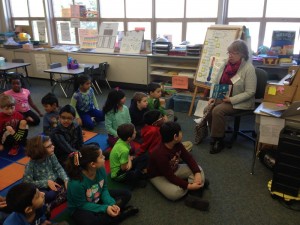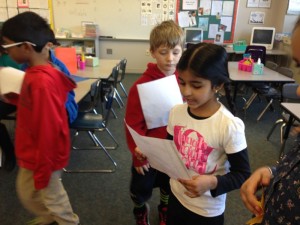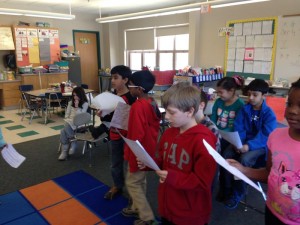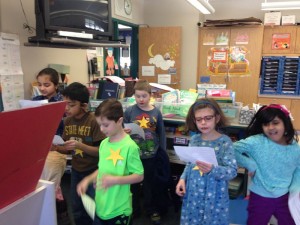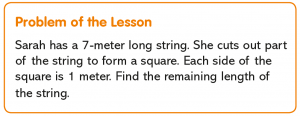Posted by kavery508 | Posted in Uncategorized | Posted on March 9, 2015
Our Read Across America event was a blast! Shrewsbury artist Pat Erickson volunteered her time and talents reading Dr. Seuss’s The Cat in the Hat Comes Back to our class. She also modeled our core value of promoting lifelong learning by explaining the importance of reading in her own life as mother, business woman, and artist. A big ‘thank you’ to her and all the community members who made the day a success.
As a way to bring reading to life, students learned to read a script and then act out Dr. Seuss’s The Sneetches. This activity gave us a means to practice fluent and expressive reading while reinforcing understanding of story structure and narration. Our day ended with a celebration of all things reading-related at our Grades 1 & 2 School Meeting, at which students were treated to “Seuss-isms” (life lessons from Dr. Seuss books), a visit from “The Cat” (Mrs. Martel’s husband, in costume), and a read-and-think aloud by guest reader and 4th grade teacher, Mrs. Edgren.
 Our CAFE focus on grammar & English skills continue as we learn about verbs, verb tenses, and adjectives. You can play games at home to reinforce these skills using ABC Ya: http://www.abcya.com/parts_of_speech_quest.htm, and the Web abounds with practice pages like these from one of my favorite sites, Have Fun Teaching: http://www.havefunteaching.com/worksheets/english-worksheets/parts-of-speech-worksheets.
Our CAFE focus on grammar & English skills continue as we learn about verbs, verb tenses, and adjectives. You can play games at home to reinforce these skills using ABC Ya: http://www.abcya.com/parts_of_speech_quest.htm, and the Web abounds with practice pages like these from one of my favorite sites, Have Fun Teaching: http://www.havefunteaching.com/worksheets/english-worksheets/parts-of-speech-worksheets.
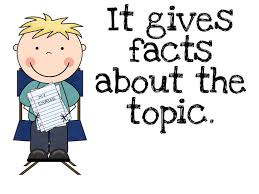 Students will be writing a second Informative Writing piece this week. They will choose their own topics based on personal expertise; organize their compositions using the Grade 2 Informative Pillar; take ever more ownership of explaining their thinking in coherent sentences; and edit for spelling and English conventions.
Students will be writing a second Informative Writing piece this week. They will choose their own topics based on personal expertise; organize their compositions using the Grade 2 Informative Pillar; take ever more ownership of explaining their thinking in coherent sentences; and edit for spelling and English conventions.
 This week we begin chapter 7 of Math in Focus, the goal of which is to make students proficient with linear measurement (especially meters and centimeters). To begin, students will learn the importance of standard units of measurement and be introduced to content-specific vocabulary (width; height; length; meter; etc.). They will next develop a sense of how big meters and centimeters are. Then they will learn correct methods for estimating and accurately measuring and talking about measurement (more than, less than, about, exactly). And as always, they will be asked to solve real-world problems that require analysis and application of skills learned. Consider the following problem from this week’s lessons. Notice how it requires students to think about space, length, multiplication/repeated addition, and subtraction to solve it:
This week we begin chapter 7 of Math in Focus, the goal of which is to make students proficient with linear measurement (especially meters and centimeters). To begin, students will learn the importance of standard units of measurement and be introduced to content-specific vocabulary (width; height; length; meter; etc.). They will next develop a sense of how big meters and centimeters are. Then they will learn correct methods for estimating and accurately measuring and talking about measurement (more than, less than, about, exactly). And as always, they will be asked to solve real-world problems that require analysis and application of skills learned. Consider the following problem from this week’s lessons. Notice how it requires students to think about space, length, multiplication/repeated addition, and subtraction to solve it:
 In Social Studies this week we will learn about in-between directions (NE, SE, NW, SW) and apply this skill to solving problems and finding places on local, national, and world maps. We often apply skills using a trivia game in which I or the students make up questions having to do with one of the maps mentioned that require students to practice the ability to use map features (map key, symbols, natural and cultural features, country borders, directions, and more). I encourage you to do the same at home. Making up questions helps to stretch your child’s knowledge and understanding of the subject. Baseball fans may be interested in a game we play called Where Are Your Sox?, in which students use a political map of the U.S. and Canada to find the home state/city/country of the team the Red Sox are playing against any given day/week. You can find maps of every kind at National Geographic Online: http://maps.nationalgeographic.com/maps, and the Red Sox season schedule at: http://boston.redsox.mlb.com/schedule/?c_id=bos#y=2015&m=3&calendar=DEFAULT
In Social Studies this week we will learn about in-between directions (NE, SE, NW, SW) and apply this skill to solving problems and finding places on local, national, and world maps. We often apply skills using a trivia game in which I or the students make up questions having to do with one of the maps mentioned that require students to practice the ability to use map features (map key, symbols, natural and cultural features, country borders, directions, and more). I encourage you to do the same at home. Making up questions helps to stretch your child’s knowledge and understanding of the subject. Baseball fans may be interested in a game we play called Where Are Your Sox?, in which students use a political map of the U.S. and Canada to find the home state/city/country of the team the Red Sox are playing against any given day/week. You can find maps of every kind at National Geographic Online: http://maps.nationalgeographic.com/maps, and the Red Sox season schedule at: http://boston.redsox.mlb.com/schedule/?c_id=bos#y=2015&m=3&calendar=DEFAULT

